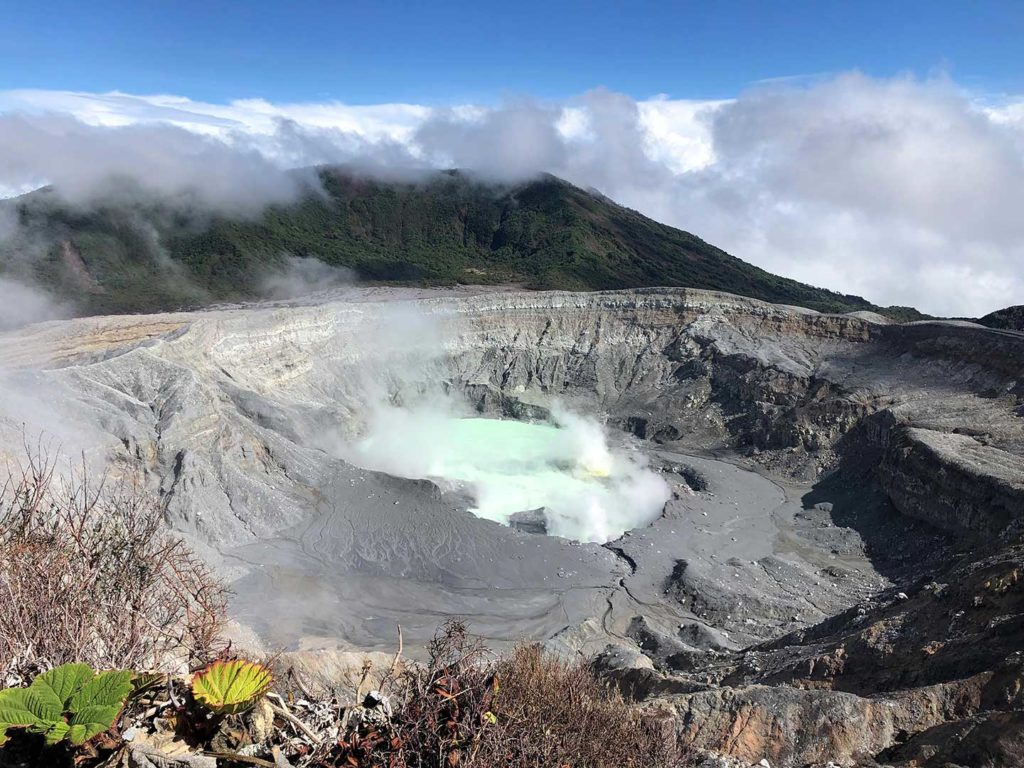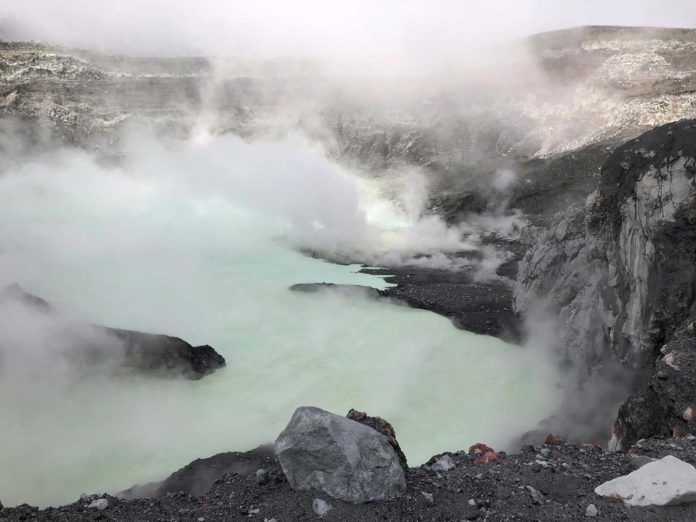Past acid-sulfate hydrothermal systems on Mars have promise in their ability to have hosted life for billions of years. One method for analyzing these systems is to study analog environments on Earth. To assess the astrobiological potential of Martian acid-sulfate hydrothermal systems, the crater lake of the active Poás Volcano, Laguna Caliente, was sampled in 2013 and 2017.
The hydrothermal crater lake of the Poás Volcano in Costa Rica is one of the most hostile habitats on the planet. The water is ultra-acidic, full of toxic metals and near-ambient to boiling temperatures, pH fluctuations from −0.87 to 1.5, a wide range of chemistries and redox potential, and frequent phreatic-to-phreatomagmatic eruptions. In addition, recurrent ‘phreatic eruptions’ cause steam, ash, and rock explosions. Despite such deadly eruptions, hydrothermal environments may be where the earliest forms of life began on Earth—and potentially on Mars if there ever was life. Beyond discovering how life can survive these harsh conditions, studying these microbes provides clues about if and how life might have existed on Mars.
In a new publication in Frontiers in Astronomy and Space Science, researchers reported that a few specialist microbes survive conditions analogous to those of Mars’ early history, which may be thanks to a broad range of adaptations.
“The science discipline of Astrobiology is rather broad and leads to research ranging from studying the origins of life on Earth to searching for extraterrestrial life on alien worlds. To prepare for space missions with key goals to find signs of life on these extraterrestrial planets and moons, we must better understand how life in these environments may look like. The search for signs of past life on Mars is a key NASA priority, demonstrated in 2021 by the arrival of the Perseverance rover on the Red Planet. As of the time of this writing, neither extant life nor definitive signs of past life on Mars have been found; however, the habitability of Mars has been assessed to great detail.” Study quotes.

“One of our key findings is that, within this extreme volcanic lake, we detected only a few types of microorganisms, yet a potential multitude of ways for them to survive,” says first author Justin Wang, a graduate student at the University of Colorado Boulder, in the United States. “We believe they do this by surviving on the fringes of the lake when eruptions are occurring. This is when having a relatively wide array of genes would be useful.”
This current interdisciplinary collaboration follows up on prior work from 2013. At that time, the researchers found that just one microbial species were coming from the Acidiphilium genus in the Poás volcanic lake. Unsurprisingly, this type of bacteria is commonly found in acid mine drainages and hydrothermal systems, and they are known to have multiple genes adapted to diverse surroundings.
The 2017 samples contain a larger diversity of bacteria, including Acidiphilium spp. and Asaia spp, known acidophiles. However, the study also represented members of the Bradyrhizobiaceae, Chitinophagaceae, and Methylobacteriaceae families.
The chief question resulting from these findings is “why would a microbial community need so many ways to produce energy when there is an essentially unlimited source of energy (sulfur, in many oxidation states) present?” While sulfur oxidation through the Sox system yields less energy in the absence of soxD gene, there still remains an effectively unlimited supply of sulfur in various redox states present in Laguna Caliente to make up for the absence of soxD gene. We provide three potential explanations to this question.” Study quotes.
Through DNA sequencing of the lake samples, the team confirmed that the bacteria had a wide variety of biochemical capabilities to help them tolerate extreme and dynamic conditions potentially. These included pathways to create energy using sulfur, iron, arsenic, carbon fixation (like plants), both simple and complex sugars, and bioplastic granules (which microorganisms can create and use as energy and carbon reserves during stress or starvation).
“We expected a lot of the genes that we found, but we didn’t expect this many given the lake’s low biodiversity,” says Wang. “This was quite a surprise, but it is absolutely elegant. It makes sense that this is how life would adapt to living in an active volcanic crater lake.”
Despite the often lethal surroundings, hydrothermal systems provide most of the key ingredients for the evolution of life, including heat, water, and energy. This is why leading theories for both Earth and Mars focus on these locations. So far, previous efforts in search of life on Mars have focused on streambeds or river deltas, but the authors suggest that more attention should be given to the sites of past hot springs (which were present on Mars for billions of years).
“Our research provides a framework for how ‘Earth life’ could have existed in hydrothermal environments on Mars,” explains Wang. “But whether life ever existed on Mars and whether or not it resembles the microorganisms we have here is still a big question. We hope that our research steers the conversation to prioritize searching for signs of life in these environments; for example, there are some good targets on the crater rim of Jezero Crater, which is where the Perseverance rover is right now.”
Journal Reference
- Justin L. Wang, Nicholas B. Dragone, Geoffroy Avard, and Brian M. Hynek; Microbial Survival in an Extreme Martian Analog Ecosystem: Poás Volcano, Costa Rica. Frontiers in Astronomy and Space Science. DOI: 10.3389/fspas.2022.817900
